This artist's concept illustrates a dwarf star surrounded by three planets. Such stars are dimmer and smaller than our sun. Credit: NASA/JPL-Caltech
SEATTLE, Nov. 29 (UPI) -- Life may exist on planets orbiting dying or failed stars such as white or brown dwarfs although they are likely not the best candidates, a U.S. astronomer says.
White and brown dwarf stars are nothing like our sun, but both still glow and so could be orbited by planets with the right ingredients for life, Rory Barnes of the University of Washington said.
White dwarfs are the hot cores of dead stars and brown dwarfs are failed stars, objects not massive enough to start nuclear burning as the sun does, but both can be bright enough to theoretically support a habitable zone, a region of space where an orbiting planet's surface water could be in liquid form, thus giving life a chance.
However, both types of dwarf stars slowly cool and become less luminous over time, so their habitable zones gradually shrink inward.
A planet in such a shrinking zone would "face a difficult path to habitability," Barnes said, even if they're discovered right in that habitable zone.
Such a planet probably lost the means to host life as it would have spent some time at the inner edge of the zone where the heat would have turned it into a runaway greenhouse, like Venus in our solar system, long before the shrinking habitable zone moved inward to place it in the center, Barnes said.
"These planets, if we find them today in a current habitable zone, previously had to have gone through a phase which sterilized them forever," he said in a university release.















